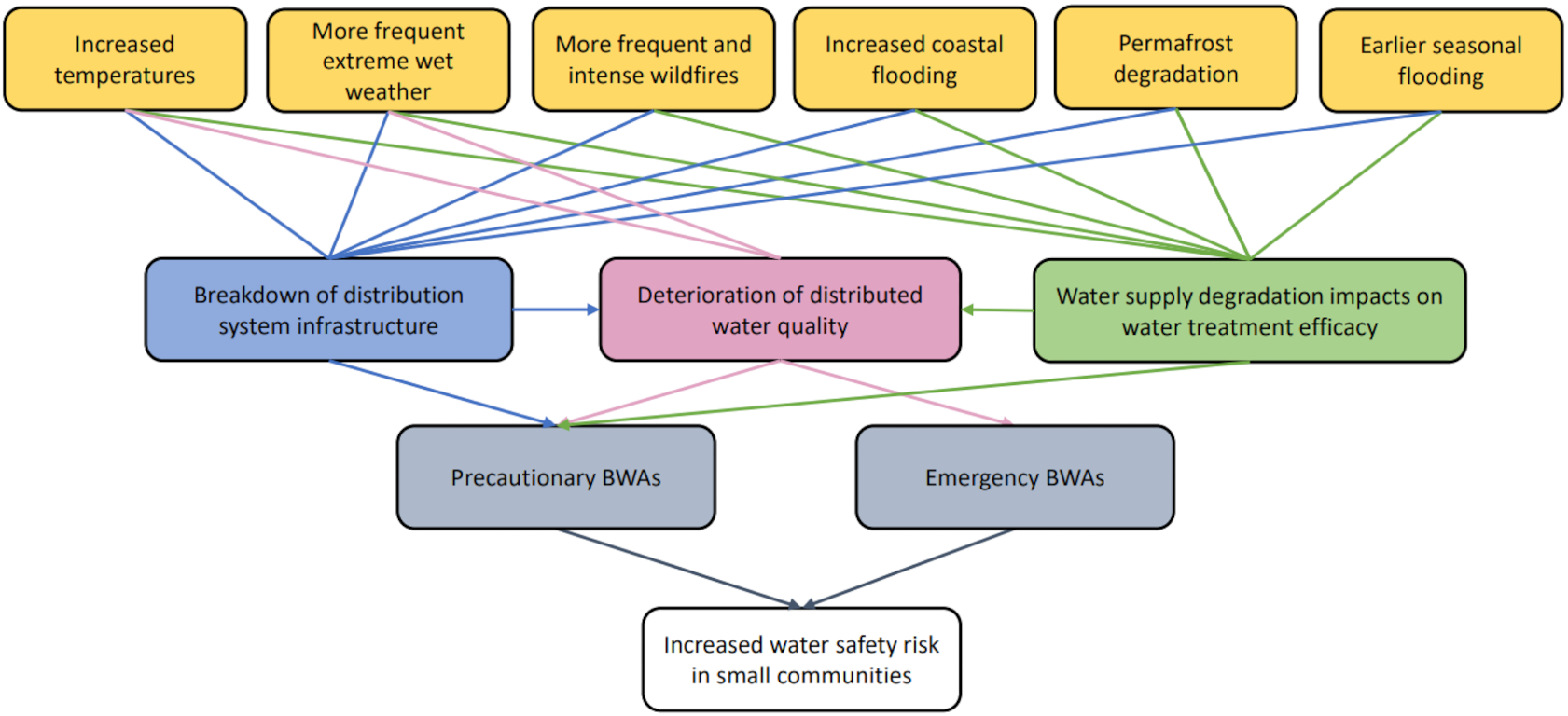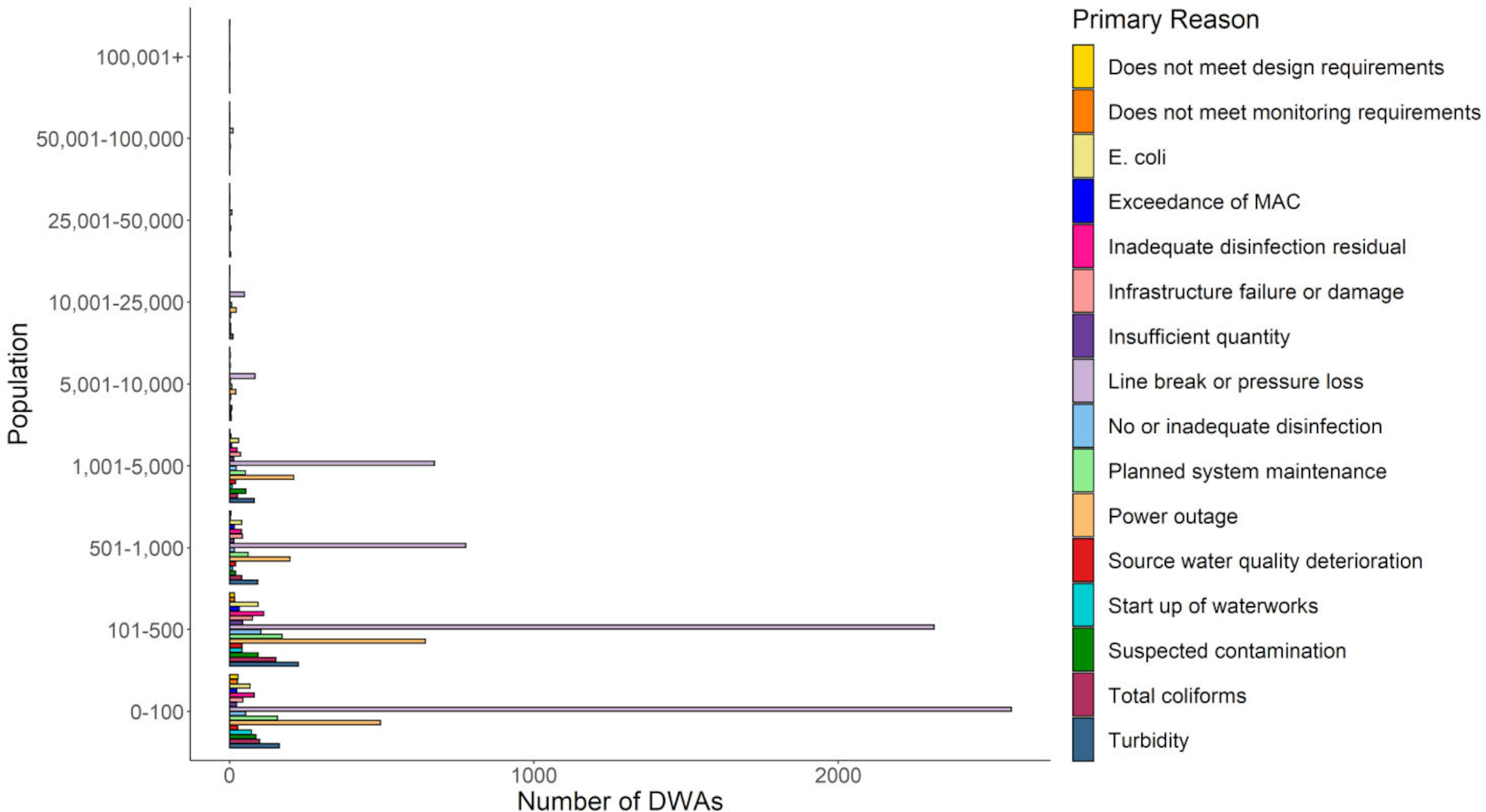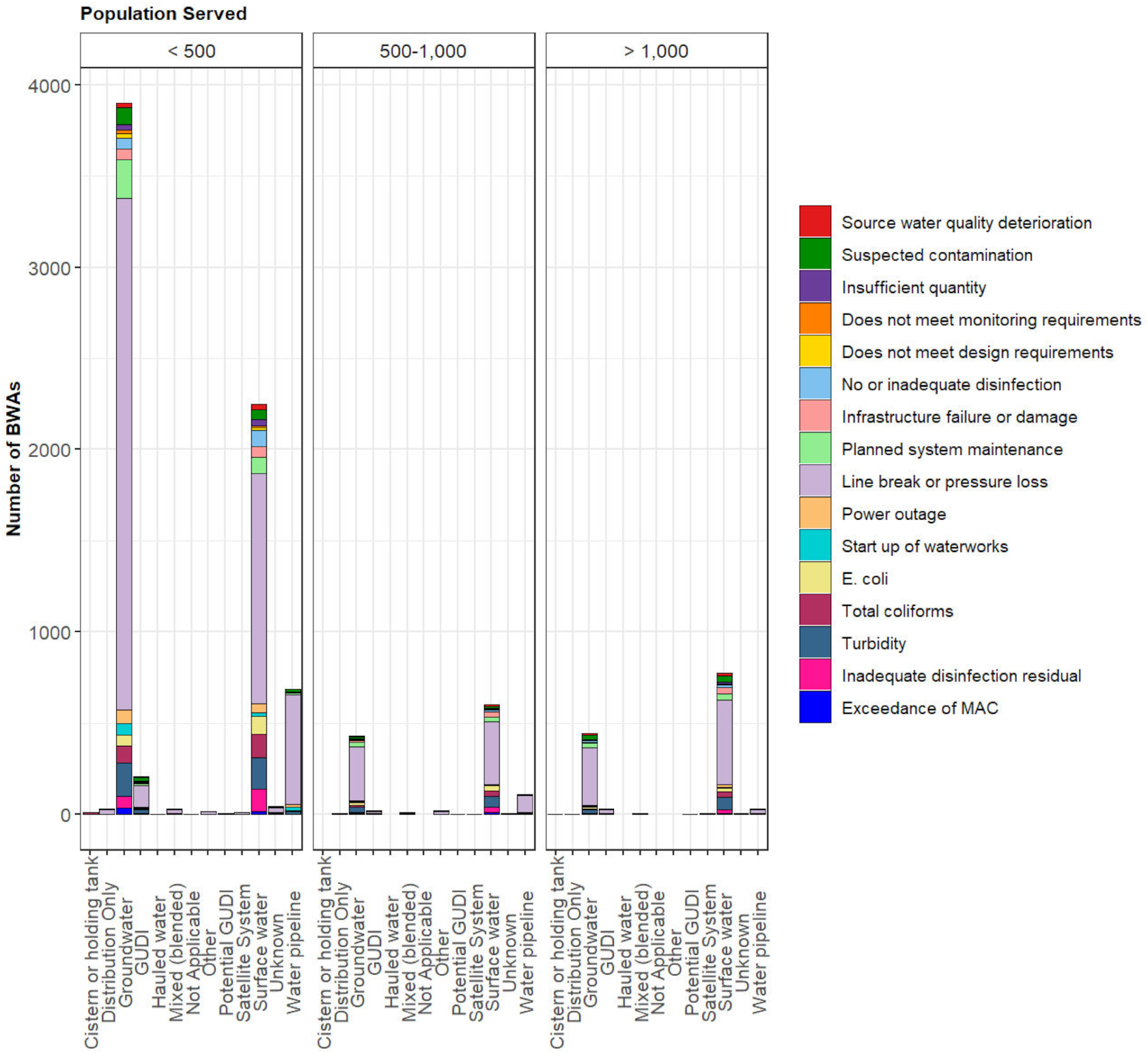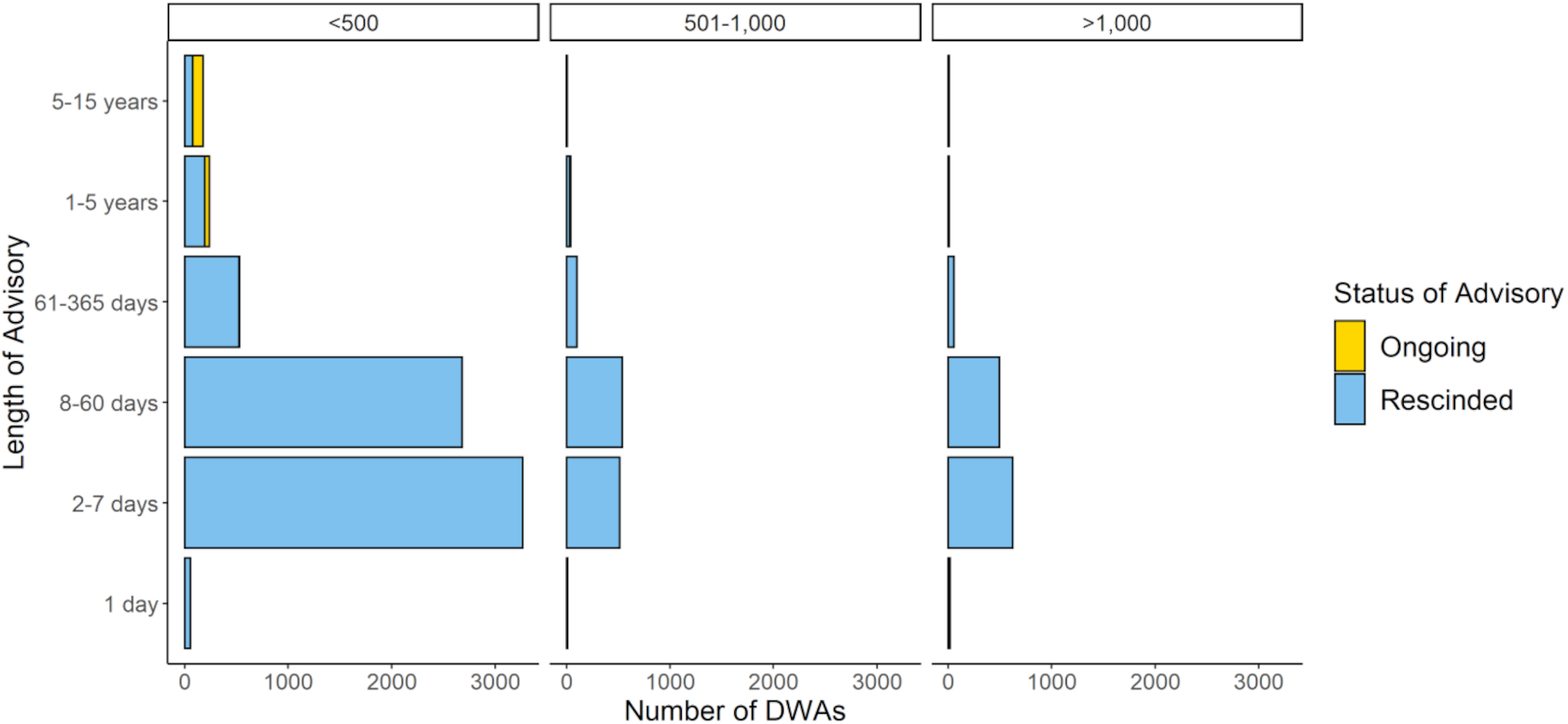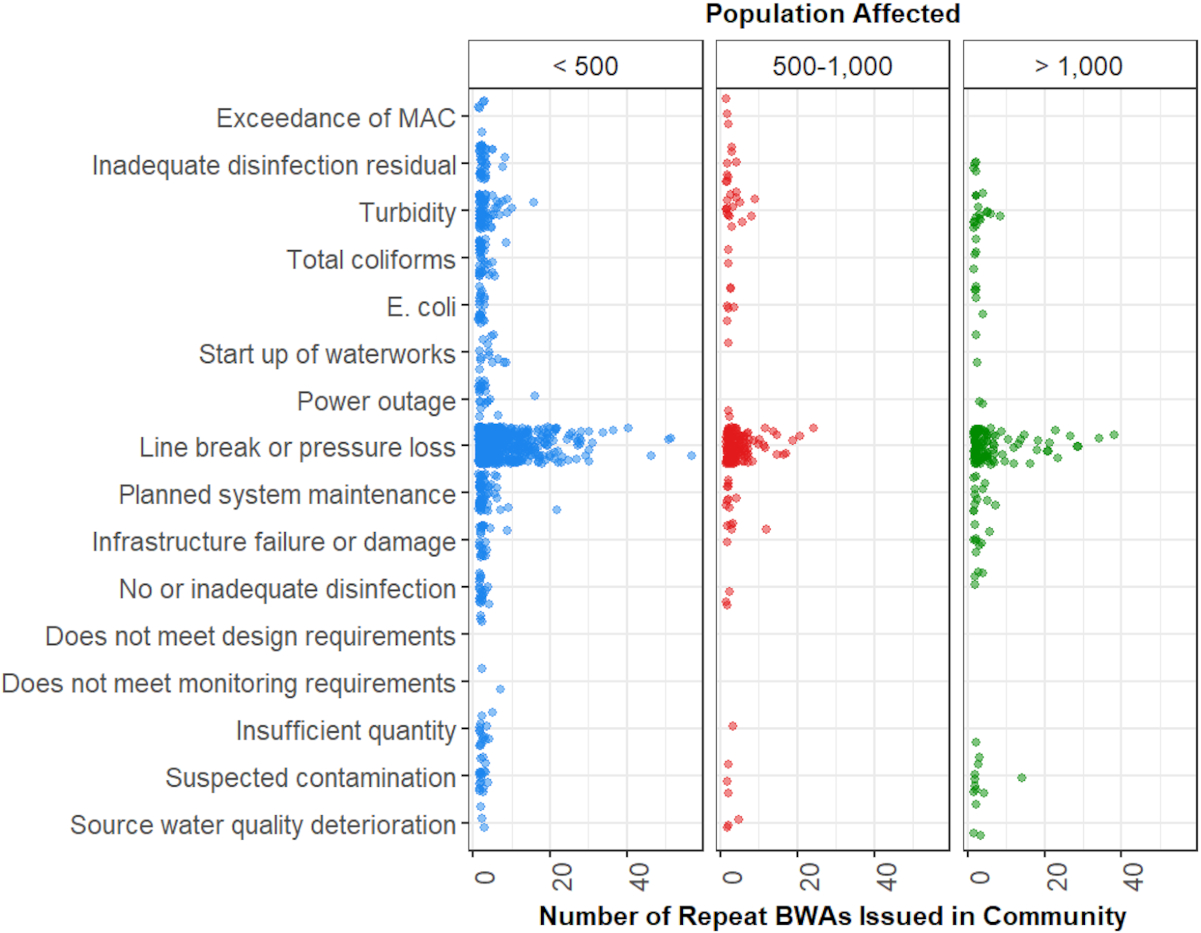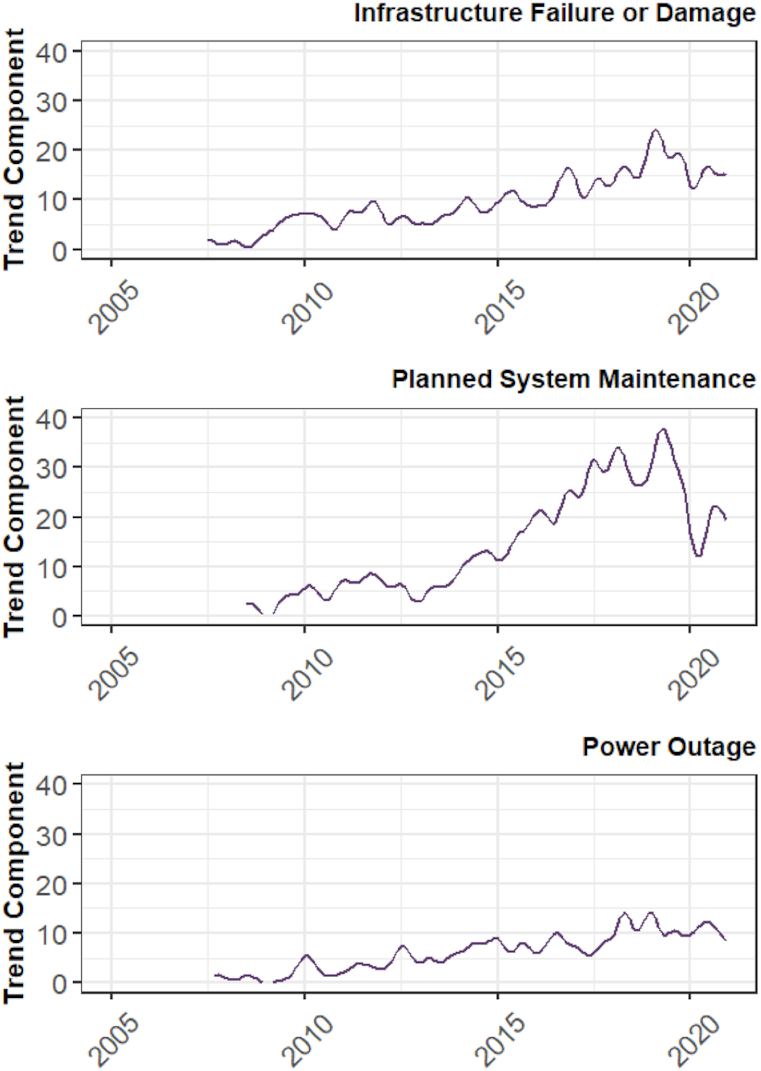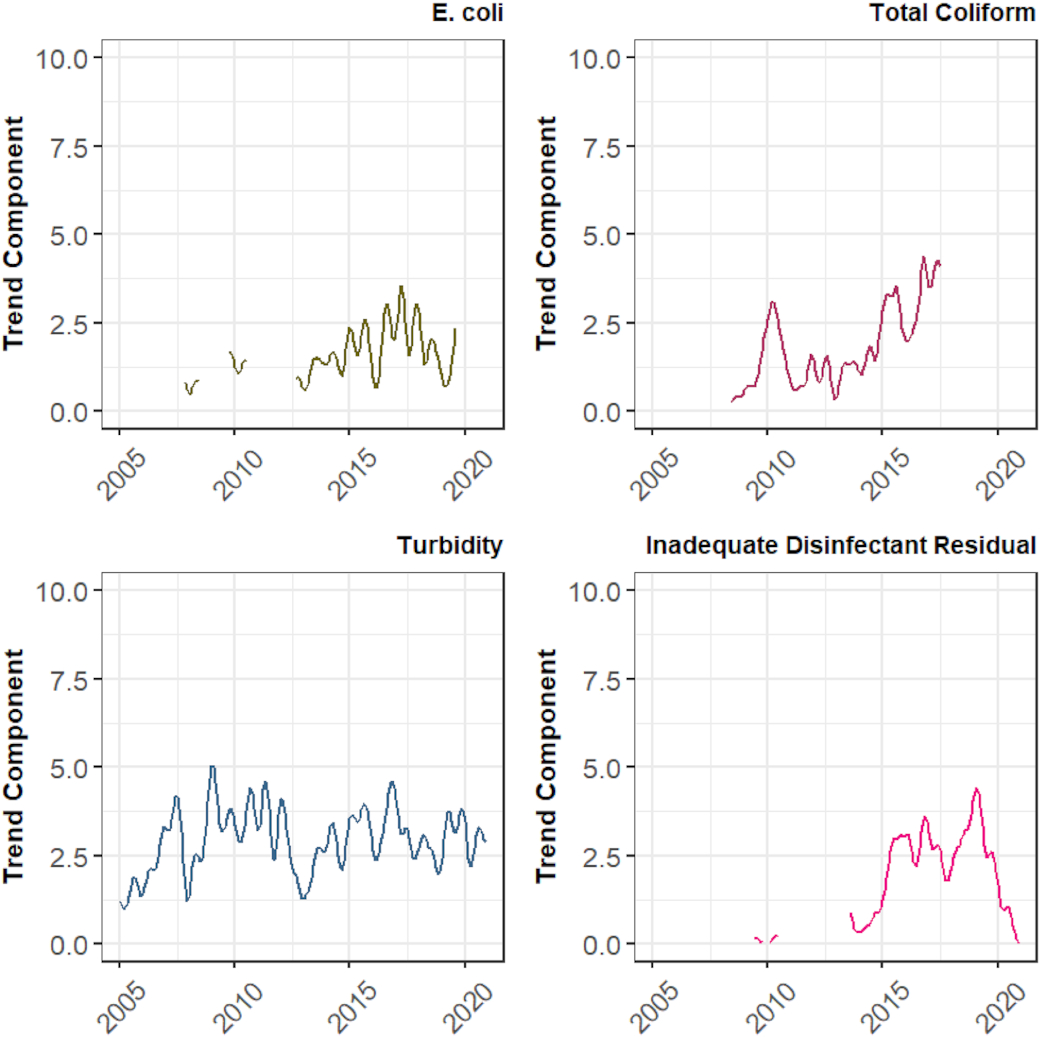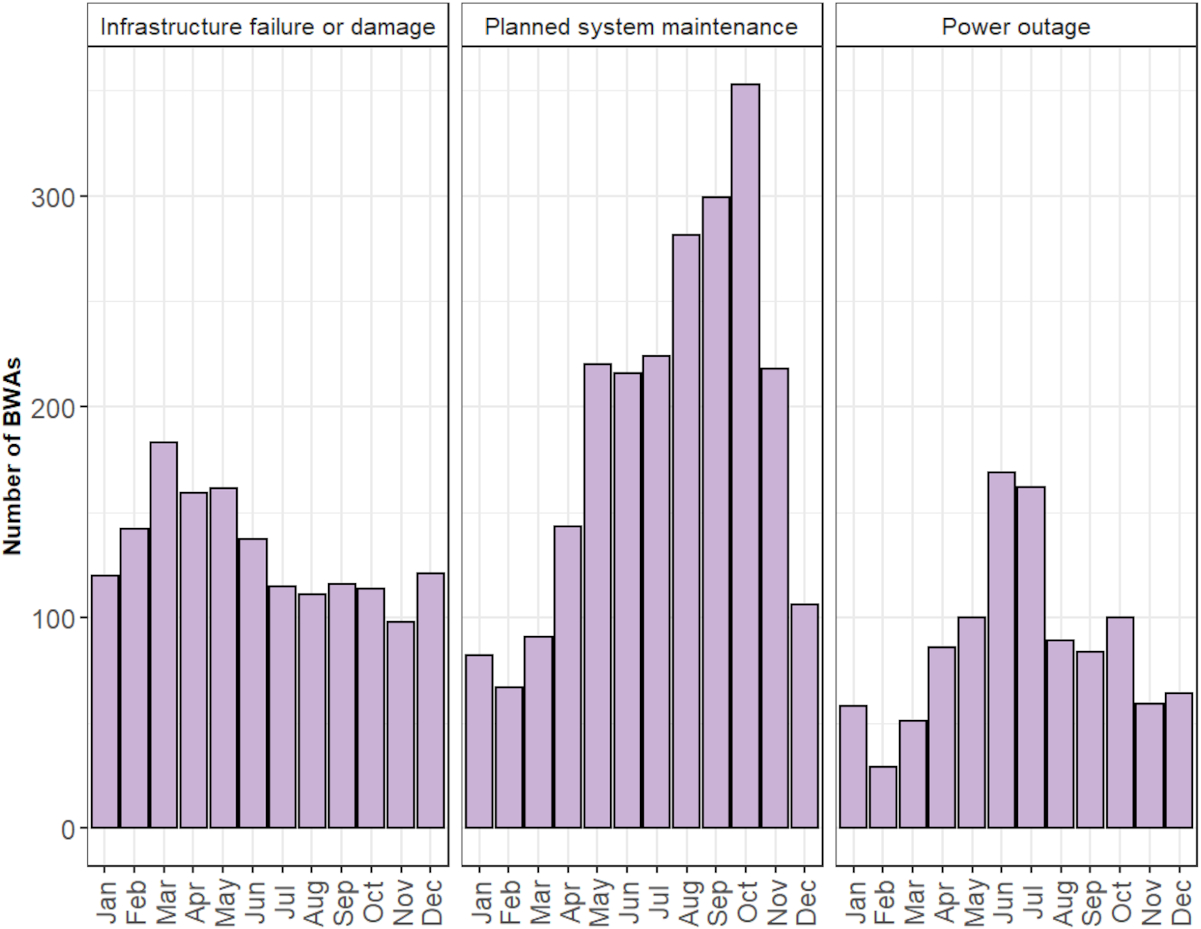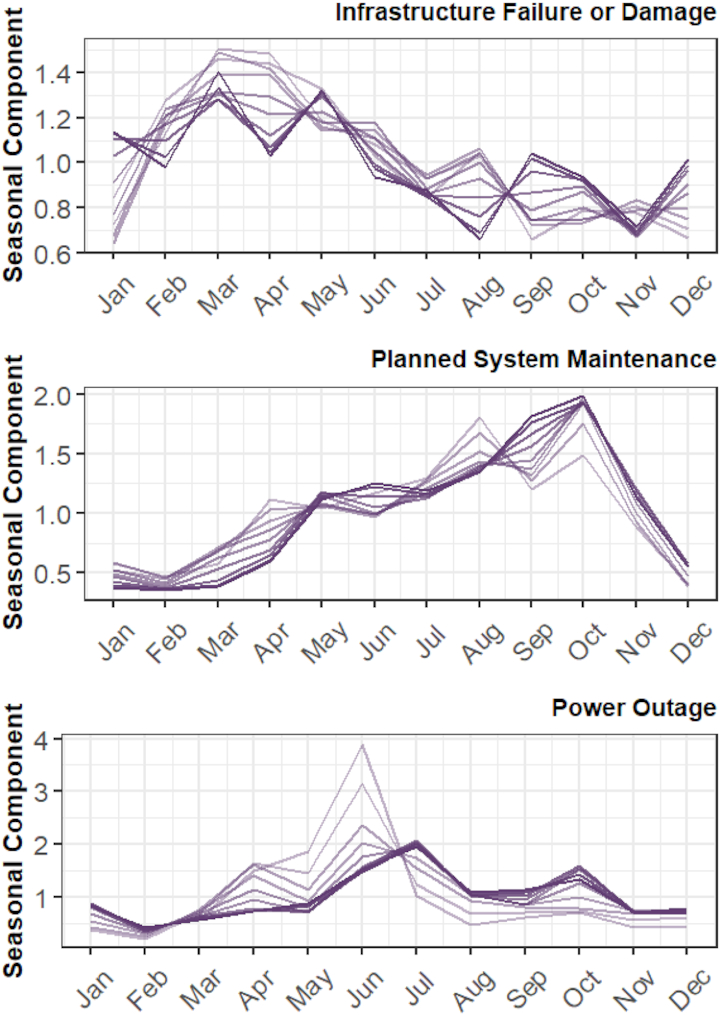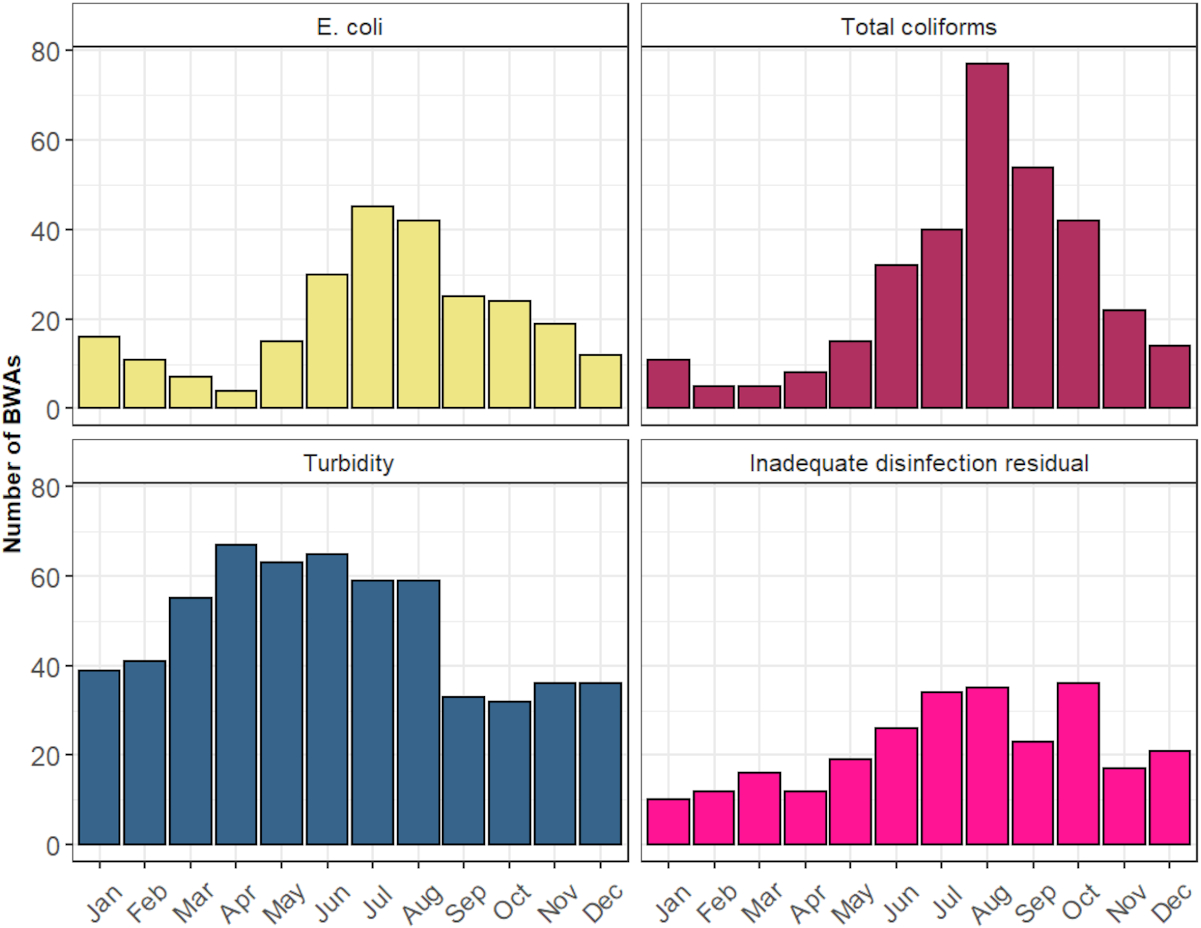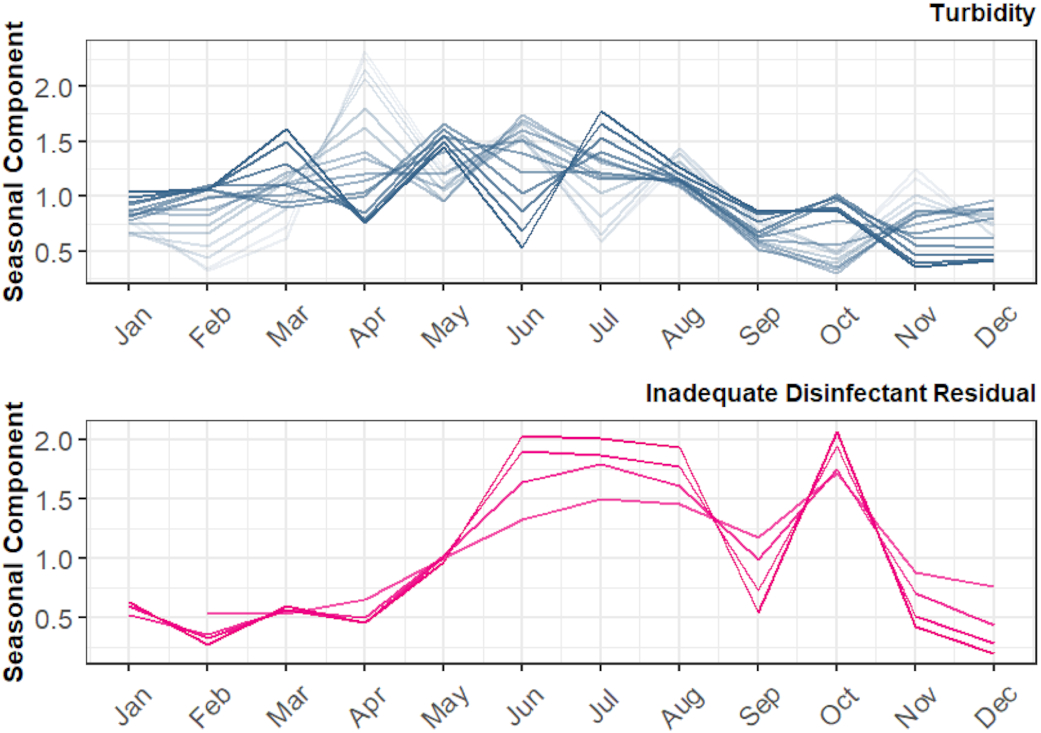1. Introduction
Drinking water safety is a persistent concern in small, rural, remote, and Indigenous communities in Canada (
Health Canada 2015;
Lane and Gagnon 2020;
Environment and Climate Change Canada 2022). Boil water advisories (BWAs) are public announcements advising users that they should boil their drinking water prior to consumption to eliminate any suspected or confirmed disease-causing microorganisms in the water (
Health Canada 2015). Emergency BWAs are issued in response to confirmed detection indicators of fecal contamination in distributed drinking water (
Health Canada 2015). Precautionary BWAs are issued when one of the steps from the source to the tap has the potential to cause fecal contamination of distributed drinking water, including source water quality or quantity changes; insufficient, poorly operated, or malfunctioning water treatment equipment; and damaged distribution system infrastructure (
Health Canada 2015). Common themes reported in previous water safety studies in Canada include the lack of consistent BWA-reporting methods from one jurisdiction to the next, the challenge of compiling and completing accurate data sets, and inconsistent reporting formats across federal and provincial jurisdictions (
Lane and Gagnon 2020). This results in issues and gaps in data sets, making it difficult to accurately understand and address the problems that underlie BWAs in Canada. Complete Canada-wide data sets for either municipal, private, or Indigenous (First Nations, Métis, and Inuit) water systems are difficult for the public to access or non-existent (
Lane and Gagnon 2020), though it should be noted that due to the federal government’s initiative to end all BWAs in First Nation communities by 2021, several academic and government-commissioned studies have highlighted and made recommendations to address BWA trends over time in these communities (e.g.,
Lane and Gagnon 2020).
BWAs are intended to be used as short-term public health interventions, and repeat and long-term BWAs can diminish users’ trust of their drinking water (
Health Canada 2015;
Minnes and Vodden 2017). Lack of trust in drinking water quality and safety can push users towards more expensive options like bottled water (
Doria 2006;
Castleden et al. 2015) or motivate people to collect water from untreated streams and springs, though the latter can also be driven by local preferences and cultural traditions (
Goldhar et al. 2013). BWAs can also introduce safety concerns such as an increased risk of scalding when consumers are boiling and using the water and can have economic impacts on local businesses and services (
Health Canada 2015). Under most circumstances, it is not necessary to boil tap water for non-consumptive household purposes such as bathing, showering, laundry, or washing dishes. However, in the event of a confirmed waterborne outbreak, it may be necessary to take additional precautions, some of which can be difficult, tedious, and(or) expensive for consumers to comply with, especially for long periods of time (
Health Canada 2015).
The warming of the Earth and the effects of changing climate over several decades has been linked to changes in the hydrological cycle, including increasing atmospheric water vapour content; changing precipitation patterns, intensity, and extremes; reduced snow cover and widespread melting of ice, including glaciers; and changes in soil moisture and runoff (
Bates et al. 2008). In Canada, the expected effects of climate change include substantially higher mean annual and seasonal temperatures, increased incidence and frequency of excess heat, extreme wet weather events, sea level rise and increased coastal flooding, more frequent and severe forest fires, and permafrost degradation, among others (
Bush et al. 2022). The extent and timelines of these changes will depend on whether and how soon greenhouse gas emissions are reduced across the world and how different interrelated climate factors interact with one another (
Bush et al. 2022). Some of these climate change effects are likely to impact the integrity and operation of water infrastructure and may therefore impact the number, length, and types of BWAs issued in Canada, a fact that is beginning to be reflected in design standards in some parts of Canada. An example of this is the Atlantic Canada Water Supply Guidelines (
Koljin 2021;
ACWWA 2022). The potential effects of extreme weather events related to climate change on drinking water infrastructure, water quality, and the frequency of BWAs has only begun to be explored in the academic literature. A series of recent government and non-governmental reports have highlighted the potential impacts of climate change phenomena on water infrastructure (
Swanson et al. 2021;
Bush et al. 2022). Our study aimed to identify the most common causes of BWAs in Canada, highlight the likely impacts of climate change on drinking water infrastructure, and explore how climate change phenomena might affect the overall number and underlying causes of BWAs in Canada.
This study was the first to conduct a Canada-wide assessment of the potential impacts of climate change on water safety as indicated by the reasons, frequency, and length of BWAs and to conduct an in-depth statistical analysis of the seasonality of BWA reasons in Canada. This study consists of an in-depth review of academic and industry-related literature related to water safety and climate change with a focus on factors relevant to Canada. Various keywords were used to identify academic and grey literature that provided an understanding of the current implications of climate change in Canada, as well as their relation and impacts on water safety. A review and analysis of historical BWA records from the Canadian Network of Public Health Intelligence (CNPHI), a public health surveillance and alerting resource of the Public Health Agency of Canada (PHAC), was conducted to determine the leading causes of BWAs in Canada. The data were aggregated and analysed based on various parameters, such as population, reason for BWA, and water source, to identify trends and consistencies within each parameter and with each other. This review also consisted of a statistical analysis of historical BWA records using X12 ARIMA decomposition followed by the Mann–Kendall test. The anticipated impacts of this study are to provide a high-level assessment of the potential impacts of climate change on water safety and BWAs in Canada.
2. Methodology
2.1. Literature review methodology
Four major scholar databases (Omni, Scholars Portal, ProQuest, and EBSCOhost) related to environmental science and engineering as well as a search engine (Google Scholar) were used to identify literature related to climate change, BWAs, and water quality. The analysis of historical BWA records, as described later in this section, was used to identify relevant key search words and literature, which included boil water advisories, climate change, water, water quality, coliforms, and extreme weather. These keywords were searched together, interchangeably, using the databases search method that allows for multiple terms to be searched in order of relevancy. The databases identified literature with these keywords in the titles, keywords, abstracts, and citations.
Information about BWAs and climate change is not limited to the peer-reviewed academic literature. Many high-quality “grey”, or non-academic, literature sources are publicly available and contain important information related to water safety and the potential impacts of climate change on drinking water infrastructure. These include the Intergovernmental Panel on Climate Change (IPCC) Sixth Assessment Report, Canada’s Changing Climate Report, reports prepared by reputable non-governmental organizations like the International Institute for Sustainable Development, and numerous Health Canada documents. The Public Infrastructure Engineering Vulnerability Committee (PIEVC) Engineering Protocol for Infrastructure Vulnerability Assessment and Adaptation to a Changing Climate and the United States Agency of International Development’s Climate Risk Screening and Management Tools (
USAID 2017) were also reviewed for this study. The academic and industry literature sources consulted in this study were supplemented with interviews with industry experts who provided further insight into the intersections between water safety and climate change impacts in Canada. A total of 96 papers about the impacts of climate change on drinking water sources and infrastructure were reviewed in this study. Of these, 15 were about increasing temperatures, 30 were about flooding due to extreme weather and changes in snow and ice cover, 23 were about coastal flooding, 14 were about drought, 6 were about wildfires, and 8 were about permafrost degradation.
2.2. Review, analysis, and visualization of drinking water advisory data
Historical BWA records for drinking water systems across Canada were provided by the CNPHI, a public health surveillance and alerting resource of the PHAC. The data included information about BWAs issued from 4 February 2005 to 8 July 2021 in multiple Canadian jurisdictions and included 9825 records, each of which represented a single BWA. Each BWA record included information about the drinking water supply type, status, water quality reason, operational reason, estimated population affected, the dates when the BWA was issued and rescinded, and the drinking water source type.
A total of 1630 communities are represented in the database, but as a condition of the data sharing agreement with CNPHI the data was provided in an anonymized format and no information was provided about the location of the communities that experienced BWAs. According to the agency, anonymization was required because the data provided to CNPHI belongs to the individual agencies who collect and report it (
Environment and Climate Change Canada 2022).
Jurisdiction over drinking water safety is primarily held by provincial and territorial governments in Canada; thus, BWA criteria and processes vary from one Canadian jurisdiction to the next, making it difficult to compare data from one region to another (
Lane and Gagnon 2020). To overcome this, CNPHI assigns each BWA in their database a primary reason and a secondary “operational reason” that together can be used to aggregate data and explore BWA trends in Canada as a whole.
Primary reasons included measures of treated and(or) distributed water quality such as turbidity,
Escherichia coli, total coliforms, and inadequate disinfection residual, as well as infrastructure-related reasons such as “line break and pressure loss in distribution system”, indicating a breakdown in the water distribution system or “significant deterioration of source water quality”. Some primary reasons, such as “exceedance of maximum accepted concentration” were open to interpretation. Secondary reasons included “planned system maintenance”, “treatment unable to cope with source water deterioration”, “power outage resulting in system power loss or reduced storage of treated water”, “contamination during construction, repair, or operation”, and “inadequate disinfection residual in distribution system”, among others. In 15% of cases, however, the primary reason was listed as “not applicable”, and in these instances, the secondary operational reason was assumed to be the primary reason for the BWA.
Equation 1 summarizes this approach:
Primary reasons that accounted for less than 0.5% of all BWAs were removed from the analysis to simplify visualization and interpretation of the results. The resulting data set included 9728 individual BWA records.
Drinking water source types were categorized as groundwater, surface water, cistern or holding tank, groundwater under the influence of surface water (GUDI), hauled water, high-risk GUDI, potential GUDI, water pipeline, mixed (blended), unknown, and satellite system. GUDI is defined as a groundwater source that is located close enough to nearby surface water, such as a river or lake, to receive direct surface water recharge (
Howe n.d.). The formal definition of GUDI differs from one jurisdiction to the next; however, GUDI is usually defined as any water beneath the surface of the ground with significant occurrence of insects; other macro-organisms, algae, organic debris, or large-diameter pathogens such as
Giardia lamblia or
Cryptosporidium; or significant and relatively rapid shifts in water characteristics such as turbidity, temperature, conductivity, or pH that clearly correlate to climatological or surface water conditions (
Nova Scotia Enviroment n.d.). A water pipeline system is one where water is transported via a water pipe from another community’s water source. A satellite system is a drinking water system that receives water from another drinking water system through a service relationship or hub system. A cistern or holding tank is a waterproof receptacle for holding water. The provided data set may have contained some variations in source water identification, particularly pipeline, region distribution systems, partial area advisories, area-wide advisories, or blended systems. Consultation with CNPHI confirmed that pipeline, regional distribution system, satellite system, and blended system all referred to water systems that were fully or partially supplied by a water pipeline from outside of the community. Due to the anonymity of the database, it is unclear which advisories are for partial areas, a full city, or town.
Each BWA in the database was assigned an estimated population range by CNPHI. The smallest range was 0–100 people and the largest was >100 000.
The length of each BWA was computed by subtracting the date that the BWA was issued from the date that it was rescinded. In the case of BWAs that were ongoing at the end of the covered period (4 February 2005 to 8 July 2021), the length of the BWA was assumed to be the difference between the date that the BWA was issued from 1 July 2021.
All data visualizations were prepared in R using the ggplot2 and gridExtra packages. Time series analysis was conducted using MATLAB 2022b. X12 autoregressive moving average (ARIMA) filter (
Findley et al. 1998) followed by the Mann–Kendall test being used to identify the presence of monotonic increasing or decreasing trends in the reasons why BWAs were called over time. The X12 ARIMA filter decomposes a time series into the trend, seasonal, and irregular components, which can then be evaluated separately. The presence of seasonality in BWA reasons was identified using the sample autocorrelation function and visualized using the X12 ARIMA filter. The autocorrelation function defines how data points in a time series are related on average to the preceding data points. All significance tests were conducted at the 95% confidence level.
6. Conclusions and recommendations
Canada has and will continue to experience an increase in both frequency and intensity of extreme weather events, which can directly and indirectly impact drinking water infrastructure and overall drinking water safety. The main ideas and conclusions of this review can be summarized as following:
•
Climate change phenomena such as increased temperatures, sea level rise, flooding, drought, forest fires, and permafrost thaws can have negative impacts on drinking water sources and infrastructure.
•
Most of the BWAs that were issued in Canada between 2005 and 2020 were related to the failure of distribution system infrastructure.
•
Small communities experience the most frequent, long-term, and repeated BWAs than larger communities.
•
A disproportionate number of BWAs were associated with groundwater supplies.
•
Seasonal trends exist in the number of BWAs issued due to line breaks and pressure losses in the distribution system and distributed water quality concerns.
Thus, climate change phenomena that result in changes in seasonal weather patterns and(or) that negatively impact distribution system components, groundwater sources, and small and remote communities should be front of mind for utilities and other practitioners aiming to increase the resilience of their water infrastructure. Based on our analysis, we have five recommendations for how this work could be expanded and used to develop sustainable and resilient drinking water solutions in Canada.
Recommendation #1: Use case studies and regional data sets to elucidate the impacts of regulatory approaches, system design guidelines, and local climate projections on water safety.
Different regions of Canada have and will continue to experience different climate extremes across various climate aspects (
Bush and Lemmen 2019). The vulnerability of each region to climate change depends on the type of extreme weather event being considered; although national climate change adaptation policies have been proposed, it’s important for region-specific and locally adapted policies to be developed to address these differences (
Luh et al. 2015). We recommend that our current analysis be expanded by collecting and analyzing data from different jurisdictions in Canada in collaboration with relevant governmental bodies and other stakeholders. This would enable a more granular exploration of the potential intersections among water safety (as indicated by BWAs), water infrastructure, and climate change. This would also allow for a more accurate evaluation of seasonal effects without interference from changing reporting and data collection methods. Some jurisdictions, including NB and NL, maintain public BWA databases on their provincial government websites (
Lane and Gagnon 2020), though the former only includes data from 2020 to 2023 and the latter is limited to current BWAs. In-depth historical BWA data for First Nations in Canada can be gleaned from existing academic and industry literature (e.g., (
Neegan Burnside Ltd. 2011), and Indigenous Services Canada maintains a list of boil water advisories called in First Nations communities in 2022 and 2023 on their website, but it is worth noting that in recent years important concerns have been raised about Indigenous data sovereignty (
The First Nations Information Governance Centre 2019), and these should be taken into account during any future analysis of BWA data from Indigenous communities.
Recommendation #2: Cross-reference BWA and other water safety data with water infrastructure costing data and socioeconomic indicators to better understand the cost and social impacts of climate change on drinking water systems and water users.
The short- and long-term monetary costs of BWAs are not well understood. We recommend that existing data related to BWAs in Canada be disaggregated by jurisdiction and location and cross-referenced with the cost of designing, building, and operating water infrastructure. Data should also be collected regarding the socioeconomic costs of BWAs, particularly repeat and long-term BWAs, on small communities. This information will help governments prioritize solutions that are most likely to increase infrastructure resilience, water safety, community well-being, and short- and long-term emergency preparedness planning (e.g., evacuation or forced migration due to deteriorated water safety).
Recommendation #3: Mobilize industry expertise to develop cost-effective and sustainable long-term water safety solutions that are resilient to expected climate change phenomena.
The American Water Works Association’s State of the Industry Report, which collects data from water professionals across North America, listed “renewal and replacement of aging water infrastructure” as the most important issue facing the water industry in 2022. Long-term water supply availability, emergency preparedness, and source water protection were also in the top 10 (
AWWA 2022). Clearly, water industry professionals are aware of the vulnerabilities identified in the current study and eager to contribute their expertise to address them. We propose that this industry knowledge and drive be harnessed to ideate climate resilient, economically sustainable, and culturally appropriate solutions to these problems.
Frameworks for this have already been proposed. The Public Infrastructure Engineering Vulnerability Committee protocol combines the expertise of professional and local stakeholders, and location-specific climate information is used to produce a realistic estimate of the severity of an infrastructure-climate interaction (
PIEVC 2016). The First Nations Resilience Toolkit (FN-IRT), released in 2020, is an example of how the original PIEVC tool can be adapted to include important jurisdictional and cultural considerations. Summaries of past PIEVC projects and an example of the application of the FN-IRT (
Stantec Consulting Ltd. 2020) can be accessed online (
https://pievc.ca/). Similarly, a joint exercise between the Water Research Foundation and the National Research Council of Canada (
Imran et al. 2009) combined established water chemistry concepts with stakeholder engagement activities to identify the potential downstream impacts of water treatment process changes on distribution system infrastructure and distributed water quality. Many other models, frameworks, and consultative processes that could be used to better understand existing problems and develop solutions have been proposed in the literature and by government bodies. We recommend that these be reviewed along with the PIEVC and the Water Research Foundation project and piloted with representative stakeholder groups in Canada.
Recommendation #4: Harmonization of BWA policies and reporting procedures across Canada
Each jurisdiction in Canada, including the 10 provinces, 3 territories, and areas under federal jurisdiction, has a distinct set of policies, criteria, and implementation procedures for BWAs. This results in a lack of consistency and general form in the collected data and information, making it difficult to compile an accurate and consistent data set (
Lane and Gagnon 2020). Harmonization of BWA policies and record keeping across Canadian jurisdictions is no simple matter, but it would greatly benefit future research and policy development. The CNPHI database is an important step in the right direction.
Recommendation #5: Work to shift public perception of water safety in Canada from BWAs to a more holistic and comprehensive understanding of safe water.
The near exclusive focus on BWAs in public discourse is problematic as BWAs do not address other water safety concerns, including metals (e.g., lead), cyanotoxins, legacy industrial contamination, or endocrine-disrupting compounds. Opening up the public conversation to include multiple water safety concerns, instead of simply BWAs, would give the public a better understanding of the complexity of water quality and safety. Finally, BWAs are reactive, not proactive, and are implemented from the top down. This is an understandable but nonetheless disempowering approach to water safety that clearly is not working for many of the smallest and most vulnerable communities in Canada. An alternative approach is required that explicitly accounts for aesthetic water quality, local environmental conditions, and cultural practices and preferences.
